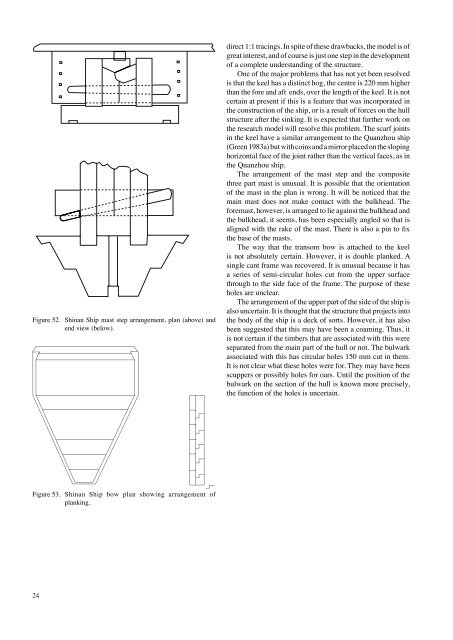No. 237 Maritime Archaeology in the People's Republic of China ...
No. 237 Maritime Archaeology in the People's Republic of China ...
No. 237 Maritime Archaeology in the People's Republic of China ...
Create successful ePaper yourself
Turn your PDF publications into a flip-book with our unique Google optimized e-Paper software.
Figure 52. Sh<strong>in</strong>an Ship mast step arrangement, plan (above) and<br />
end view (below).<br />
Figure 53. Sh<strong>in</strong>an Ship bow plan show<strong>in</strong>g arrangement <strong>of</strong><br />
plank<strong>in</strong>g.<br />
24<br />
direct 1:1 trac<strong>in</strong>gs. In spite <strong>of</strong> <strong>the</strong>se drawbacks, <strong>the</strong> model is <strong>of</strong><br />
great <strong>in</strong>terest, and <strong>of</strong> course is just one step <strong>in</strong> <strong>the</strong> development<br />
<strong>of</strong> a complete understand<strong>in</strong>g <strong>of</strong> <strong>the</strong> structure.<br />
One <strong>of</strong> <strong>the</strong> major problems that has not yet been resolved<br />
is that <strong>the</strong> keel has a dist<strong>in</strong>ct hog, <strong>the</strong> centre is 220 mm higher<br />
than <strong>the</strong> fore and aft ends, over <strong>the</strong> length <strong>of</strong> <strong>the</strong> keel. It is not<br />
certa<strong>in</strong> at present if this is a feature that was <strong>in</strong>corporated <strong>in</strong><br />
<strong>the</strong> construction <strong>of</strong> <strong>the</strong> ship, or is a result <strong>of</strong> forces on <strong>the</strong> hull<br />
structure after <strong>the</strong> s<strong>in</strong>k<strong>in</strong>g. It is expected that fur<strong>the</strong>r work on<br />
<strong>the</strong> research model will resolve this problem. The scarf jo<strong>in</strong>ts<br />
<strong>in</strong> <strong>the</strong> keel have a similar arrangement to <strong>the</strong> Quanzhou ship<br />
(Green 1983a) but with co<strong>in</strong>s and a mirror placed on <strong>the</strong> slop<strong>in</strong>g<br />
horizontal face <strong>of</strong> <strong>the</strong> jo<strong>in</strong>t ra<strong>the</strong>r than <strong>the</strong> vertical faces, as <strong>in</strong><br />
<strong>the</strong> Quanzhou ship.<br />
The arrangement <strong>of</strong> <strong>the</strong> mast step and <strong>the</strong> composite<br />
three part mast is unusual. It is possible that <strong>the</strong> orientation<br />
<strong>of</strong> <strong>the</strong> mast <strong>in</strong> <strong>the</strong> plan is wrong. It will be noticed that <strong>the</strong><br />
ma<strong>in</strong> mast does not make contact with <strong>the</strong> bulkhead. The<br />
foremast, however, is arranged to lie aga<strong>in</strong>st <strong>the</strong> bulkhead and<br />
<strong>the</strong> bulkhead, it seems, has been especially angled so that is<br />
aligned with <strong>the</strong> rake <strong>of</strong> <strong>the</strong> mast. There is also a p<strong>in</strong> to fix<br />
<strong>the</strong> base <strong>of</strong> <strong>the</strong> masts.<br />
The way that <strong>the</strong> transom bow is attached to <strong>the</strong> keel<br />
is not absolutely certa<strong>in</strong>. However, it is double planked. A<br />
s<strong>in</strong>gle cant frame was recovered. It is unusual because it has<br />
a series <strong>of</strong> semi-circular holes cut from <strong>the</strong> upper surface<br />
through to <strong>the</strong> side face <strong>of</strong> <strong>the</strong> frame. The purpose <strong>of</strong> <strong>the</strong>se<br />
holes are unclear.<br />
The arrangement <strong>of</strong> <strong>the</strong> upper part <strong>of</strong> <strong>the</strong> side <strong>of</strong> <strong>the</strong> ship is<br />
also uncerta<strong>in</strong>. It is thought that <strong>the</strong> structure that projects <strong>in</strong>to<br />
<strong>the</strong> body <strong>of</strong> <strong>the</strong> ship is a deck <strong>of</strong> sorts. However, it has also<br />
been suggested that this may have been a coam<strong>in</strong>g. Thus, it<br />
is not certa<strong>in</strong> if <strong>the</strong> timbers that are associated with this were<br />
separated from <strong>the</strong> ma<strong>in</strong> part <strong>of</strong> <strong>the</strong> hull or not. The bulwark<br />
associated with this has circular holes 150 mm cut <strong>in</strong> <strong>the</strong>m.<br />
It is not clear what <strong>the</strong>se holes were for. They may have been<br />
scuppers or possibly holes for oars. Until <strong>the</strong> position <strong>of</strong> <strong>the</strong><br />
bulwark on <strong>the</strong> section <strong>of</strong> <strong>the</strong> hull is known more precisely,<br />
<strong>the</strong> function <strong>of</strong> <strong>the</strong> holes is uncerta<strong>in</strong>.

















